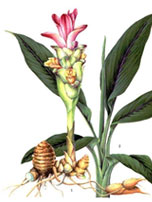SHAHEED KARTAR SINGH SARABHA AYURVEDIC MEDICAL COLLEGE & HOSPITAL
Affiliated to Guru Ravidas Ayurved University, Hoshiarpur Punjab
Affiliated to Guru Ravidas Ayurved University, Hoshiarpur Punjab

Botanical Name: Curcuma longa Linn.
Family: Zingiberaceae
Introduction : It used for skin diseases& prameha. it is considered as an important anti diabetic and anti-oxidant drug.
Scientific Classification : Gingers make up the family Zingiberaceae in the order Zingiberales. The flavoring ginger is classified as Zingiber officinale, East Indian arrowroot as Curcuma angustifolia, and tumeric as Curcuma longa. The banana belongs to the family Musaceae and is classified as Musa paradisiaca. The traveler’s tree, classified as Ravenala madagascariensis, and the bird-of-paradise flower, classified as Strelitzia reginae, belong to the family Strelitziaceae (sometimes Musaceae). The false bird-of-paradise belongs to the genus Heliconia of the family Musaceae (sometimes Heliconiaceae)
Names in different Indian languages :
English : Turmeric
Hindi : Haldi
Kannada : Arisina
Malayalam : Mannal,manjal,varattu mannal, pachamannal
Sanskrit : Haridraa
Tamil : Manzal
Telugu : pasupu
Unani : Zard Chob
Synonyms :
Priyaka, Haridruma, Kshanda, Gauri, Kaanchani, Krimighna, Varavarnini, Yoshitapriyaa, Hattavilaasini, Naktaahvaa, Sharvari,Curcuma domestica Val.
Classification according to Charaka, Susrutha & Vagbhata :
Charaka : Lekhaniya, Kustaghna, Kandaghna, Krmighna, Sirövirecana
Susrutha : Haridrãdi, Mustädi,
Vagbhata : Haridrãdi, Mustädi,
Varieties & adulterants – (CV – controversy, AD – adulterants) :
1. C. Domestica
2. Amragandhi Haridra (Karpura Haridrã)
3. Vana Haridrã
Morphology :
Annual herb; root stock large, ovoid; sessile tubers thick, cylindrical, bright yellow inside.
Leaves— long petiole; oblong, narrow at the base.
Flower— bracts pale green; flowers as long as the bracts, pale green. Flowers during rainy season.
Distribution & Habitat :
Cultivated throughout India.
Chemical constituents :
1% volatile oil, resin, curcumin is responsible for its colour. Turmeric oil has a peculiar odour and taste. Curcumene, Curcumenone, curcone, curdione, cineole, curzerenone, epiprocurcumenol, eugenol, camphene, camphor, borneol, procurcumadiol, procurcumenol, curcumins, ukonan A, B & D, sitosterol etc.
Properties :
Rasa : Tikta, Katu
Guna : Rüksa, Laghu
Virya : Usna
Vipaka : Katu
Karma : Kapha-vãtahara, Lekhana, Visaghna, Varnya
Anti-inflammatory, anti diabetic, cholagogue, hepatoprotective, blood-purifier, antioxidant, detoxifier and regenerator of liver tissue, antiasthmatic, anti-tumour, anticutaneous, antiprotozoal, stomachic, carminative
Indication :
Prameha, Kusta, Krimi, Kandu, Vrana, Pãndu, Kãmalã
Diabetes, skin disease, skin disease, fungal infection, wounds, ulcers, anaemia, jaundice, epilepsy, syphilis
Part used :
Rhizome
Dosage :
Fresh juice 10-20 ml, powder 2-4 g.
Important Yogas or Formulations :
Haridrã Khanda, Vrana södhana tailam ,Nisamalaki,Haridrãdidhüma varti
Therapeutic Uses :
1. Vyanga— Haridra and Rakta Cañdana are made into paste with buffalo’s milk and applied externally (R.R.S.).
2. Slipada & Dadru Kutha— Haridra powder is taken with jaggery and Cow’s urine (V.M. & B.P.).
3. Pitameha— Haridrã and Dãruharidrã Kasãya (S.S.Ci. 11).
